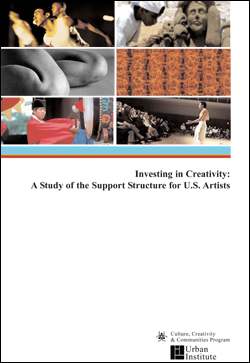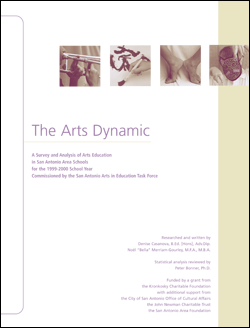Funding Research
Two related sessions at grantmaking conferences last fall addressed important questions concerning the relationship of art, culture, and the environment. In each case, funders sought practical information about creative collaboration and successful cross-sector funding. Whether labeled "arts" or "environment" funders, grantmakers craved creative ways to attract new partners — both individuals and organizations — to their work.
Read More...September 2001, 20 pages. The Cultural Policy Center at the University of Chicago.
Read More...April 2001, 96 pages. The Urban Institute, 2100 M Street N.W., Washington, D.C. 20037 (202) 833-0687
Read More...2003, 336 pages, Jossey-Bass/Pfeiffer, 989 Market Street, San Francisco, CA 94103
Read More...2003, 107pages, Urban Institute, 2100 M Street, N.W., Washington, DC 20037, (202) 833-7200, www.urban.org.
Download:
Read More...2001, 116 pages. San Antonio Arts in Education Task Force, www.saysi.org
Download:
![]() The Arts Dynamic (5Mb)
The Arts Dynamic (5Mb)
In a crowded auditorium at Yerba Buena Center for the Arts, funders, community activists, and artists gathered in March to listen to a panel discussion on hip-hop activism in the Bay Area. The goal of Constant Elevation: The Rise of Bay Area Hip-Hop Activism was twofold: to inform and educate funders about hip-hop activism and how it fits into foundation support, and to highlight local best practices that use Hip Hop as a framework.
Read More...At the GIA conference in fall, 2002, we hosted a round table discussion with the euphemistic title "Adapting in a Time of Constraints." Essentially its burden was to ask: what should we, as funders, be doing for the cultural institutions with whom we work in the context of these extraordinarily difficult times?
Read More...Editors of the Reader invited GIA's research advisors to reflect on challenges facing arts grantmakers in light of current research findings on arts funding trends.
What do recent research findings suggest about the prospect for the support of arts and culture in the years ahead?
Ed Pauly: After a decade of dramatic growth in foundations' support for the arts, the funding news is now somber. Yet the meaning we make from the most recent study of foundation funding for the arts depends, as always, on the perspective we choose.
Read More...Recently, several studies of arts funding have been conducted in specific cities and regions. We report on a few of these here. In the winter 2002 issue of the GIA Reader Vol. 13, No. 1, Lisa Cremin and Kathie de Nobriga reported on a comparative study of arts funding in Atlanta and nineteen other cities. The report was both an inspiring and a cautionary tale for Ann McQueen and others in Boston as they planned the study that Cindy Gehrig reviews below.
Read More...

